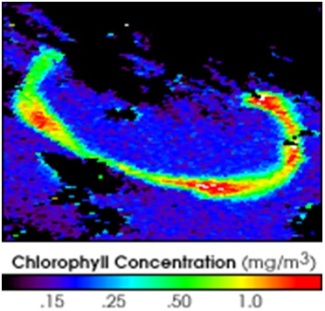Environment and Preservation

Relationship Between Oceanic Biological Productivity and Nutrient Input
For some years now, researches on the relationship between oceanic biological productivity and the entry of nutrients have been carried out. Recently, the study of three sediment cores from the Subantarctic South Atlantic Ocean have allowed researchers to interpret the stimulation of productivity as a direct response to dust supply (source of Fe micro-nutrients) in the region. These changes are interesting to study because they occur on a smaller scale than the glacial-interglacial cycles periods.
References
Anderson, Robert F.; Barker, Stephen; Fleisher, Martin; Gersonde, Rainer; Goldstein, Steven L.; Kuhn, Gerhard; Mortyn, P. Graham; Pahnke, Katharina; Sachs, Julian P. Biological response to millennial variability of dust and nutrient supply in the Subantarctic South Atlantic Ocean. Philosophical Transactions of the Royal Society 372(2019): 20130054. 2014. doi: 10.1098/rsta.2013.0054.
During a time of post-Industrial Revolution growth of atmospheric CO2, and all of it’s consequences - including global climate change, ocean acidification, and more - we are compelled to look at Earth’s past natural links between CO2 changes recorded in ice cores and the response in the global ocean (which contains about 60X as much C as the atmosphere). Specifically, how has the ocean’s biological productivity changed as a function of nutrient input, and how does this affect our understanding of the marine “biological pump” to draw down atmospheric CO2? The Southern Ocean (SO) is a key region for such oceanographic inquiry since it is directly downwind of some of the main dust inputs (and Fe micro-nutrient sources, e.g. Patagonia), it is consistently characterized by high macro-nutrients but low chlorophyll in today’s world (implying that some micro-nutrients might be missing; see top left figure for results of an SO Fe enrichment experiment), and it is adjacent to Antarctica where some of the world’s best ice core records of CO2 changes come from. Our recent paper found a tight coupling between Fe input as dust, and both lithogenic and biogenic fluxes in the surface Subantarctic South Atlantic Ocean, most importantly on millennial timescales.
Past studies have suggested several aspects of SO relationships to dust input, such as differences south and north of the Antarctic Polar Front (APF) – lower productivity during ice ages southward, but higher productivity during corresponding glacial events north of this feature - as well as conflicts and challenges between individual proxy systems as recorders of biological productivity. The Subantarctic South Atlantic sector (vs. those of the Pacific or Indian Oceans) of the SO in particular has been shown highly productive during ice ages due to its proximity to a key dust source of micro-nutrients (e.g. Fe) from the Patagonian region. So many large-scale climatic boundary conditions change during glacial-interglacial cycles however, such as sea level, ocean and atmospheric circulation, etc., that the linkage between dust-derived Fe and Subantarctic South Atlantic productivity has been begging for examination at shorter timescales that are more human relevant without the larger-scale boundary condition adjustments.
This is where the key findings of our recent paper fit in. We show with records from 3 marine sediment cores from the Subantarctic South Atlantic Ocean that 3 different paleoproductivity proxies are linked with dust (Fe) input in the Dome C ice core from Antarctica. Our preferred interpretation is that this productivity stimulation was a direct response to dust supply to the region, and most importantly at millennial timescales much finer than those of broader scale glacial-interglacial variability. This bears directly on the ocean’s role in CO2 cycling, of obvious importance not only in the past but especially so in the modern and future.
Top left figure: The results of the Southern Ocean Iron Enrichment Experiment (SOIREE) experiment in 1999 were captured by the Sea-viewing Wide Field-of-view Sensor (SeaWiFS). The bright comma in the above image indicates phytoplankton growth stimulated by iron added during the course of the experiment. (Image courtesy Jim Acker, Goddard Distributed Active Archive Center, the SeaWiFS Project,NASA/Goddard Space Flight Center, and ORBIMAGE). Source: http://earthobservatory.nasa.gov/Features/Martin/martin_5.php.
Graham Mortyn
Institute of Environmental Sciences and Technologies (ICTA)
2024 Universitat Autònoma de Barcelona
B.11870-2012 ISSN: 2014-6388
